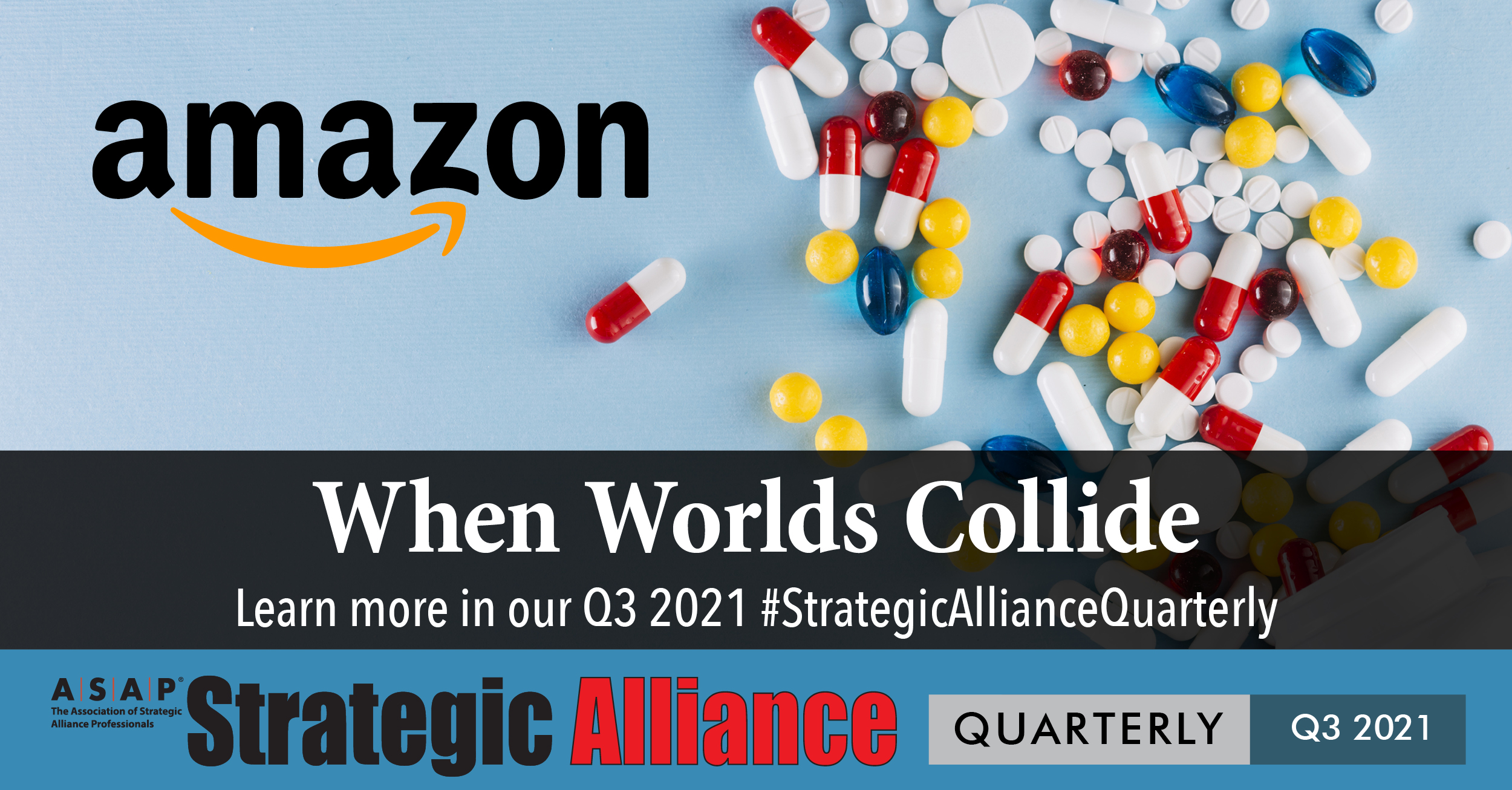The Behemoth Swallows a PillPack: Amazon Invades Healthcare
As our Q3 issue of Strategic Alliance Quarterly goes to press, it’s worth noting that one of the articles, “When Worlds Collide,” contains a number of expert insights on what’s happening as tech companies move into the domains of healthcare and biopharma. In fact our interviews, as is often the case, revealed far more about different aspects of the subject than could easily fit into the magazine article.
Over the course of our conversations, two interviewees proffered the notion that a particular event has served as a pivotal catalyst of the tech/healthcare/pharma nexus: the 2018 acquisition by Amazon of the pharmacy operator and medication delivery company PillPack. This transaction was referenced in passing in our main feature, but commentary from these observers that hit the cutting-room floor got us wondering: Can Amazon truly end up directly serving patients and pharmaceutical customers on a massive scale? And can it do it effectively?
Can Amazon Impact “That Whole Patient Experience”?
As Christine Wolff, vice president of Americas alliances at PTC, noted, Amazon—which she referred to as “the behemoth”—has already established itself behind the scenes in healthcare delivery with its infrastructure- and platform-as-a-service technologies, even before its PillPack partnership-turned-acquisition.
“They were able to marshal all of their IT knowledge and recognize the supply chain and the data infrastructure that has to support that supply chain to reach the patient—they put all those building blocks together and they’re being very agile in delivering healthcare to their clients,” she said.
Now, PillPack has brought Amazon in direct contact with pharmacy end customers. In Wolff’s mind, it isn’t far-fetched to think the retail and cloud technology giant could be administering healthcare directly if it gets creative in applying its other consumer capabilities.
“Through their logistics they can get you your medicine the same day—and while it hasn’t taken root yet, you can see Alexa saying to those who opt in, ‘Oh, Wolffie, I hear you coughing. Do you want me to get you a televisit with one of our providers?’ And have that televisit set up through the Amazon network, and then I can decide I want to go to a clinic set up in a corner of the Whole Foods store—this kind of integration of the supply chain as well as the innovation at the top end of biopharma is what’s going to matter to the patient being better. So it’s not just R&D, it’s that whole patient experience.”
No Need to Reinvent the Pharmacy Chain
If Amazon succeeds in immersing itself in direct patient treatment, it may be due in large part to a commitment to fundamental partnering principles and a willingness to accept its limitations as a company.
Danny Kim, head of corporate development for Seoul-based digital therapeutics company (and Samsung spinoff) WELT corp and a pharmacist by training, has seen the evolution of Amazon’s first healthcare success story up close and personal—as a former PillPack employee. Listening to Kim describe some of Amazon’s initial forays into this market, one gets the sense that it approached its pre-PillPack efforts with a touch of hubris, perhaps unconsciously.
“Before acquiring PillPack, Amazon was in the news trying to enter the pharmacy space by acquiring its pharmacy licenses and warehouse licenses,” Kim explained. “And then there was the partnership conversation. As the time went on, Amazon probably realized, ‘Hey, this could take us years and years, but if we work with this company [PillPack] that was founded by a pharmacist and has a deep background in the industry they’re in, that could shorten a heck of a lot of time and we wouldn’t need to reinvent the wheel.”
This newfound humility has served Amazon well and put the pharmacy industry on notice.
“If you let down your ego and acknowledge that you won’t be able to do everything, and [you’re] able to work hand in hand with someone better at what they’re good at doing, that creates the most ideal partnership,” said Kim. “Amazon has certainly done that, and [the acquisition] sent signals throughout the pharmacy industry: Amazon’s coming in the market, and things are going to change.”
Start with the Patient and Work Backward
Of course, Amazon’s path to alleviating patients’ minor aches, pains, and maladies remains littered with many legal, regulatory, and industry hurdles. Still, buoyed by PillPack’s assets, Amazon could probably apply its savvy in meeting end customers’ needs to those with the sniffles. Wolff suggested that we are already seeing this competency at work in the marketplace.
“So Amazon started thinking from the patient requirement on back, all these links in the chain, and how they could repurpose all the links they already had, as opposed to companies who think of it the other way: ‘Here’s the product we make, how can we reach [it] down to the customer in new ways?’”
Either way, Kim feels that Amazon’s acquisition of PillPack has accelerated the marriage between IT and healthcare, and that this activity will benefit patients in ways we can’t even conceptualize yet.
“There are more and more great examples of tech and pharma or tech and healthcare alliances that have been coming along the way, and I’m very excited to see where it goes next.”
For more on where the tech, pharma, and healthcare industries are going next—and how they’ll get there together—check out our feature “When Worlds Collide” in the Q3 Strategic Alliance Quarterly, coming to ASAP members’ inboxes soon.

